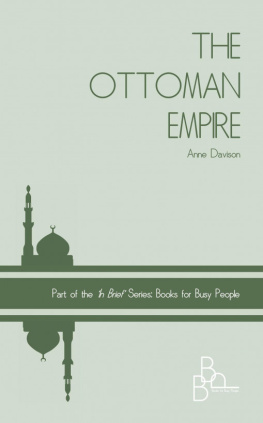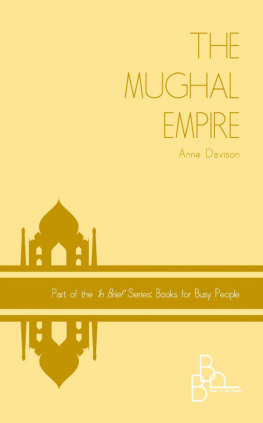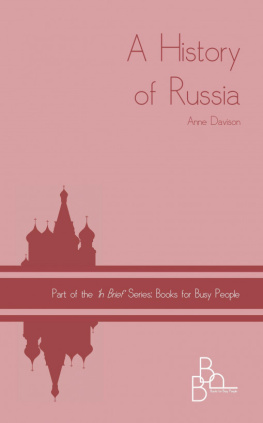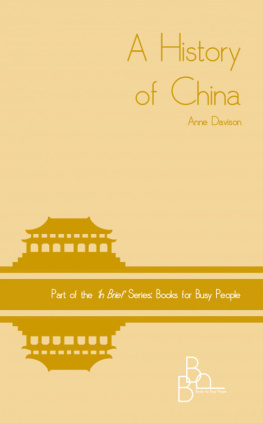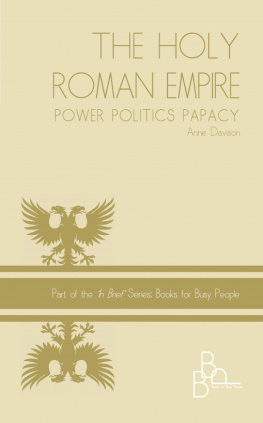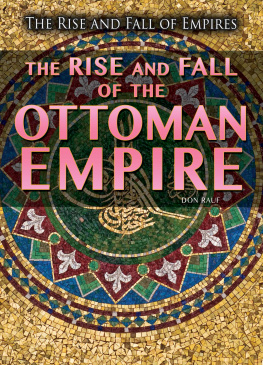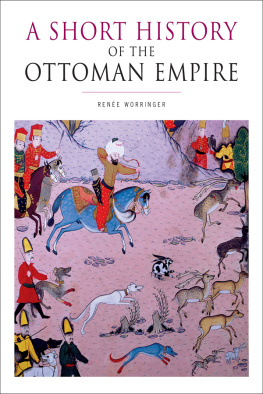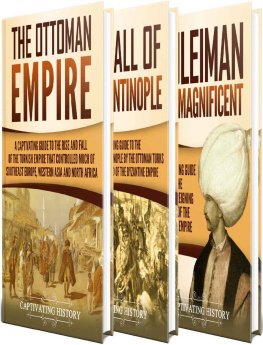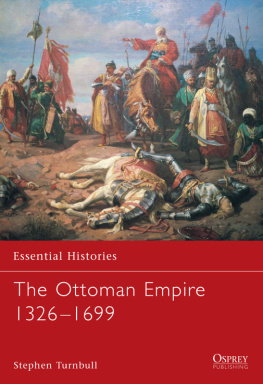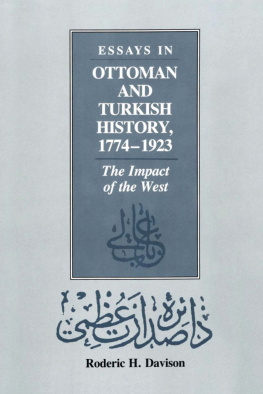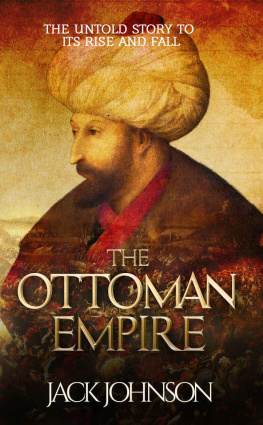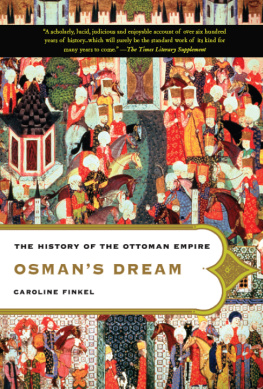THE OTTOMANEMPIRE
a briefhistory
In Brief Series: Books for Busy People
by AnneDavison
Smashwords Edition
This ebook is licensed for your personal enjoymentonly. This ebook may not be re-sold or given away to other people.If you would like to share this book with another person, pleasepurchase an additional copy for each recipient. If you're readingthis book and did not purchase it, or it was not purchased your useonly, then please return to Smashwords.com and purchase your owncopy.
Thank you forrespecting the hard work of this author
Copyright2016Anne Davison
Cover designedby Karen Turner

TABLE OFCONTENTS
MAPS
SeljukEmpire
Mongol Empire1251
Territory Under Osman I,1326
Territory Under Orhan1361
Territory Under Murad1389
AnatolianBeyliks
Contemporaries ofSuleiman the Magnificent
Ottoman Empire1566
Black Sea
Sykes-PicotAgreement
Treaty ofSevres
British and FrenchMandates
Many books havebeen written about the Ottoman Empire. Some of these are scholarlyworks written by academics. Others focus on one particular periodof Ottoman history or perhaps a particular geographic area.
This book isdifferent in that it is written for the general reader, covers theentire period of some six hundred years, and assumes no priorknowledge.
The history of theOttoman Empire, as with most Empires, is complex. It is also ahistory that is little understood by the general public. At thesame time there are many events that occurred within the context ofOttoman history that the general reader may be quite familiar with:for example, the Fall of Constantinople in 1453, the Crimean War in1853, the Battle of Gallipoli or exploits of Lawrence of Arabiaduring the First World War.
Although allOttoman history is fascinating, the period from the 18thCentury onwards is particularly important in relation to the makingof todays Eastern Europe and the Balkans. Equally, if not moreimportantly, is the period from the First World War and thedissolution of the Empire. A better understanding of this lastperiod could help many people make more sense of the complexsituation in the Middle East today.
The aim of thisbook is to offer a general overview of what is a complex history ofthe many countries and cultures that made up the Ottoman Empirewhile at the same time placing some of the more familiar eventswithin their historical context. It is rather like putting smallpieces of a jigsaw into their correct place while not losing sightof the big picture.
While there willinevitably be gaps in a work of this size it is hoped that thereader may be inspired to further reading on the subject. For thoseinterested a short selection of the main works that have beenconsulted is provided at the end of the text.
As with otherbooks in the In Brief series, this book is aimed at the generalreader who wants to understand a particular historical topic butdoes not have the time or inclination to read a heavy academictome. With this in mind, footnotes have been omitted.
Finally, I wouldlike to thank those friends and colleagues who gave of their timeto read through various chapters, proof read the script, andoffered helpful comments.
The Ottoman Empirewas officially founded in 1299 when Osman I became the firstSultan. It was abolished in November 1922 in the aftermath of theFirst World War. At its peak, during the reign of Suleiman theMagnificent in the 16th Century, the Empire covered anarea that included North Africa and Arabia, the Balkans, todaysTurkey, Syria and the Levant. During the same period the Ottomanarmy was both feared and respected by Western powers and theOttoman navy competed on an equal footing with the Genoese andVenetians for mastery of the Mediterranean Sea. In 1529, whenSuleiman led his armies right up to the walls of Vienna, panicseized the hearts of Christians in Europe and as the Turkish armiesgradually moved westwards many feared that an Islamic conquestwould lead to the demise of Christendom in Western Europe.
The founder of theEmpire, Osman I, belonged to the Oghuz tribe. The Oghuzs were aTurkic speaking people who migrated from the region of Kazakhstanin Central Asia to Anatolia during the 13th Century.Having brought the various Seljuk tribes of Anatolia under theirinfluence, the Ottomans then went on to conquer much of theBalkans, the Levant, parts of Arabia and the coastal regions ofNorth Africa. In this way the Empire became multi-national,multi-lingual and multi-religious.
The Ottomans wereSunni Muslims and for much of the Empires history, althoughnon-Muslims were subject to certain discriminatory legislation,there was never a policy aimed at their conversion to Islam.Religious communities were generally permitted to practice theirfaith and organise their own internal affairs in return for thepayment of a special government tax (jyziah tax).
By the18th Century the Ottomans were falling well behindEurope in terms of trade and industry. Valuable trade was lost dueto new markets opening up in the Far East supported by the Britishand Dutch East India Companies. Home markets suffered due togenerous trade concessions being granted by the Empire to Europeancountries. At the same time the Empires attempts at modernisationand industrialisation met fierce resistance from conservativeclerics. Western observers often blamed this situation on thetraditional conservatism of Islam. The lack of modernisation andcost of Balkan wars led the Empire into debt and it was in thiscontext that the Ottoman Empire became known in the West as theSick Man of Europe.
During the19th Century parts of the Empire, with encouragementfrom the Western powers, began to seek self-rule. This wasparticularly the case in the Balkans, an area that was largelypopulated by Christians. Russia, for example, sought specialconcessions from the Ottomans on the grounds that she had a duty toprotect her co-religionists, the Orthodox Christians andparticularly those living in Greece, Serbia and the Holy Land.Austria also claimed a special relationship with the populations ofcountries such as Hungary and Croatia based on the principle theywere all Roman Catholic. Both Russia and Austria would later arguethat they had a right to intervene in Ottoman affairs in defence ofpersecuted Christians.
Throughout the19th and early 20th Centuries nationalisticfervour and calls for independence spread across Eastern Europe andthe Balkans. These anti-Ottoman uprisings were often supported byAustria and Russia as each competed for territorial influence inthe region. Britain and France, who were wary of Russianexpansionism, also became involved in Ottoman affairs. Bothcountries were also aware of the need to protect their trade routesto the Far East.
The Ottomanresponse to these uprisings was often harsh. Images of barbarityappeared on the front pages of the Western Press. All this resultedin a change in the relationship between the Ottoman government andher religious minorities, particularly the Christians. Many leadingChristians were suspected of being spies working for Westernpowers. The Armenians in particular were suspected of being on theside of Russia. Consequently, the atmosphere of trust and tolerancetowards the minorities that had existed in the early centuries ofOttoman history began to change in the 19th Century. Tosome extent this was due an Ottoman perception that European powerswere meddling in Ottoman affairs.
While thesituation was different in other parts of the Empire, for exampleMesopotamia, the Levant and North Africa, Western involvement wasequally evident here. This was particularly the case in Egypt whenin 1805 Muhammad Ali, the Ottoman Governor in Cairo broke away fromIstanbul and established an independent dynasty with the support ofFrance. His aim was to become sole ruler of a reformed andmodernised Egypt and the Levant.

